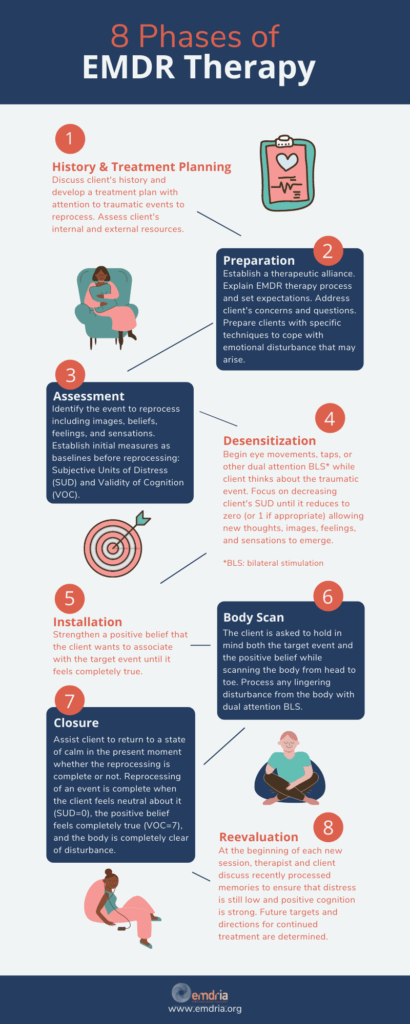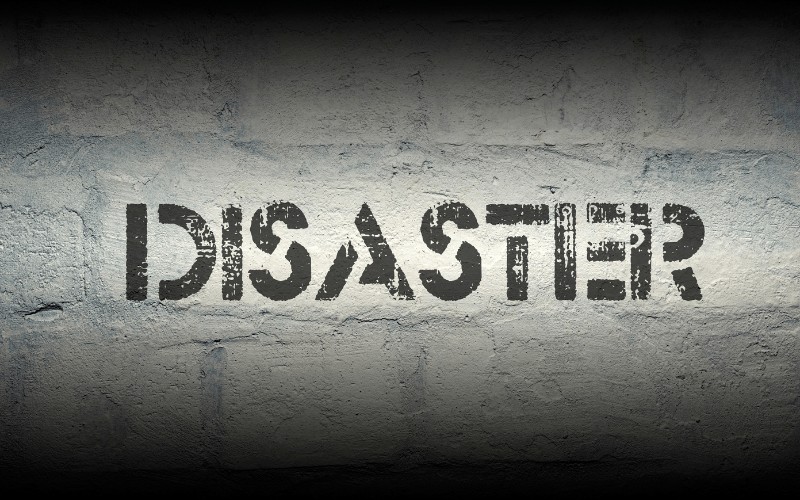The eight phases of EMDR therapy provide a framework to understand the treatment process. They act as a map for the EMDR therapist to follow. The names of the eight phases describe what happens during each phase and each phase focuses on a particular aspect of treatment (Hase, 2021). All eight phases contribute to the overall effect of EMDR therapy, however, not all phases may be used in one EMDR therapy session.
The Map of EMDR Eight Phases as a Guide
The map of the EMDR eight phases acts as a guide to the goal of EMDR therapy: to “facilitate accelerated information processing” (Shapiro, 2018, p. 83). The understanding upon which EMDR therapy is built is that every person has the natural ability to heal. We all go through difficult situations in life. Often, we are able to ‘process’ the information (images, sights, sounds, feelings, sensations, thoughts) from these events ourselves or with the help of friends and family. To clarify, ‘processing’ in EMDR therapy refers to this natural ability to integrate our emotions, beliefs, and body sensations about an experience. If an experience is ‘processed,’ we can understand that it was a negative experience, but we can also link it to positive or useful information regarding the experience. This positive or useful material could include lessons learned, helpful shifts in feeling and body sensation, remembering how strong we are, relation to past successes, or a realization of how future actions can be guided because of the experience. In other words, ‘processing’ an experience means to make sense of the experience, and also no longer feel disturbed by it.
Sometimes an experience is simply too large, painful, or shocking for a person to process by themselves. So, a therapist can help ‘reprocess’ this experience with EMDR therapy. Maybe the experience reminds a person of similar negative experiences that have occurred in the past. The experience is overwhelming or traumatic. This is when EMDR therapy can be used to jump-start our natural processing system. EMDR therapy allows the overwhelming experiences to ‘reprocess’ until they no longer feel disturbing. The eight phases of EMDR therapy provide the map to guide treatment.
The Eight Phases
The eight phases are 1) history taking and treatment planning, 2) preparation, 3) assessment, 4) desensitization, 5) installation, 6) body scan, 7) closure and 8) reevaluation.
- Phase 1: The first phase begins with a discussion between the therapist and client regarding what brings the client into therapy and how EMDR therapy can be used best for that client. The therapist and client develop a secure working relationship. The client’s history is discussed and a treatment plan is developed with attention to the pacing of therapy and the selection of traumatic events that will be part of treatment. In addition, the client’s internal and external resources are assessed.
- Phase 2: In the preparation phase, the therapist explains the EMDR therapy process, terms, and sets expectations. Any client concerns and questions are addressed and a safe therapeutic alliance between therapist and client is established. The therapist and client collaborate to prepare specific techniques to cope with any emotional disturbance that might come up. Some clients need quite a bit of time in phases 1 and 2 in order to feel ready to move on to the following phases.
- Phase 3: In assessment, the event to reprocess (also known as the target event) is identified, along with images, beliefs, feelings, and sensations about the event. Initial baseline measures are set by using the Subjective Units of Disturbance (SUD) scale and the Validity of Cognition (VOC) scale.
The next three phases are known as the ‘reprocessing’ phases and all involve dual attention bilateral stimulation (BLS). Dual attention BLS activates the client’s information processing system while keeping the client anchored in the present moment. Dual attention BLS can be side to side eye movements, sounds, or taps.
- Phase 4: In the fourth phase, desensitization, the side to side eye movements, sounds, or taps are begun while focusing on the traumatic event, and continue until the client’s SUD reduces to zero (or 1 if appropriate). During this time, new thoughts, sensations, images, and feelings may emerge.
- Phase 5: When desensitization is complete, installation begins. In this phase, the client associates and strengthens a positive belief with the target event until it feels completely true.
- Phase 6: During the body scan, the client is asked to hold in mind the target event and the positive belief while scanning the body from head to toe. Any lingering disturbance from the body is reprocessed.
The last two phases ensure safety for the client both at the end of a current session and at the beginning of the next session.
- Phase 7: Every session of reprocessing ends with the seventh phase, closure, in which the client is assisted to return to a state of calm in the present moment whether the reprocessing is complete or not. Reprocessing of an event is complete when the client feels neutral about it (SUD=0), the positive belief feels completely true (VOC=7), and the body is completely clear of disturbance.
- Phase 8: Reevaluation, is how each new session begins after reprocessing. The client and therapist discuss recently processed memories to ensure that distress is still low and that the positive cognition is still strong. Future targets and directions for continued treatment are determined.
Vídeo ocho fases de la terapia EMDR
EMDR Therapy & Your Brain Infographic
Susanna Kaufman works with content at EMDRIA, compiling and editing Focal Point blog posts while working toward her full LPC licensure in Texas.
References
Hase, M. (2021). The structure of EMDR therapy: A guide for the therapist. Frontiers in Psychology, 12, 660753. Open access: https://doi.org/10.3389/fpsyg.2021.660753
Hase, M., Balmaceda, U.M., Ostacoli, L., Libermann., P., & Hofmann, A. (2017). The AIP model of EMDR therapy and pathogenic memories. Frontiers in Psychology 8: 1578. Open access: https://doi.org/10.3389/fpsyg.2017.01578
Shapiro, F. (2018). Eye Movement Desensitization and Reprocessing Therapy: Basic Principles, Protocols, and Procedures (3rd ed.). New York, NY: The Guilford Press
Back to Focal Point Blog Homepage
Additional Resources
If you are a therapist interested in the EMDR training:
- Learn more about EMDR at the EMDRIA Library
- Learn more about EMDR Training
- Search for an EMDR Training Provider
- Check out our EMDR Training FAQ
If you are EMDR trained:
- Check out EMDRIA’s Let’s Talk EMDR Podcast
- Check out the EMDRIA Focal Point Blog
- Learn more about EMDRIA membership
- Search for Continuing Education opportunities
If you are an EMDRIA Member:
Date
August 13, 2021
Contributor(s)
Susanna Kaufman
Practice & Methods
8 Phases

![Brown-and-Orange-Aesthetic-Thesis-Defense-Presentation[1] Brown-and-Orange-Aesthetic-Thesis-Defense-Presentation[1]](https://www.emdria.org/wp-content/uploads/2021/08/Brown-and-Orange-Aesthetic-Thesis-Defense-Presentation1-1024x576.jpg)



